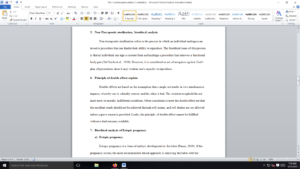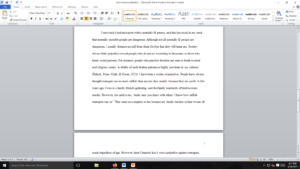Researchers often use a method called an experiment in order to study the causes of human and animal behavior. Design such an experiment based on a change in behavior you have observed in yourself or your roommates this past semester (e.g., eating or sleeping habits, exercise regime, game playing, etc.). Select a behavior that you are particularly interested in studying, and then design the experiment to investigate a possible cause of that behavior. Address the following questions.
What is the hypothesis you will test in your experiment?
What are the independent and dependent variables?
Who will be the subjects or participants in your study?
What are the experimental and control group conditions? Here, you may assume that you have the resources necessary to conduct your experiment and that you can control, or manipulate, the environment of your subjects as necessary. For example, suppose your hypothesis is as follows: Higher levels of stress from a heavy course workload increase eating activity. Assume that you have the ability to control the workload, etc., of your subjects.
How will you assign your subjects to groups?
What are the possible results of your study, and what might these results indicate about your hypothesis?
In a multi-paragraph essay, describe your experiment and explain how you will conduct this experiment to test your hypothesis. Be sure to propose your hypothesis, and then describe the independent and dependent variables, the experimental and control conditions, the subject or participant groups, and the conclusions you can draw based on the results of your experiment. Include information from class materials and readings to support your discussion. These are the structuralist perspectives, functionalism, behaviorism, etc. The book been used is Discovering Psychology:The science of Mind. This is based on chapter 1
Example:
Experimental Study: Time Scheduling and Eating Behaviors
College students are inevitably known to eat unhealthy. From Ramen noodles to Mac-n-Cheese, the typical college student searches for food that is fast, convenient, and tasty. One reason for this unwholesome lifestyle is that the “poor college student” cannot afford the fancy, expensive food. However, based on experience of being a college student myself, it seems that the bigger issue is actually that college students do not have time to cook gourmet dinners. As a result, they reach for the easy, packaged meals that are “Ready in 5 minutes.” No matter the reason, it seems that the majority of scholars fail to maintain a healthy diet. The University of Smithtown student body does not escape this stereotype, either, and falls victim to these eating habits. While the U. of Smithtown school year has only been in session for a total of three weeks this fall, I (as a student of the school), have seem my roommates eating habits change from relatively healthy to an absolute mess. Being a third year, my roommates and I must be responsible for all of our own meals: no more dining hall dinners. It can be difficult to cook every meal with healthy intentions in mind. Nevertheless, we are all usually fairly healthy people who think about what we put in our body…until recently. With the start of school, work, sports, sororities, and clubs, my roommates and I have become busier than ever. We have resorted to microwaving yesterday’s oatmeal for breakfast, coffee and a bag of chips for lunch, and even Costco pizza for dinner. In order to attempt to explain these eating habits, I will conduct an experiment to see if there is any correlation between a person’s time schedule and his or her eating habits.
This experiment will have psychological, methodical steps following the guidelines in “Discovering Psychology: The Science of the Mind” by Cacioppo and Freberg. In using systematic observation and experimentation, my experiment (a research method that tests hypotheses and allows researchers to make conclusions about causality) will have a testable hypothesis, a replicable process of steps, and as objective of results as possible by human observation. By the end of this experiment, I will attempt to find out if there is any correlation with how busy a person is and their eating habits. Eating habits in this study will entail the amount of food consumed, the type of food eaten, and when the food is eaten.
The hypothesis I propose is “If a college student becomes busier, his or her eating habits will become worse.” A hypothesis is a proposed explanation for a situation. Here, my hypothesis is based on personal observation from my roommates and friends, as well as stereotypes of college students. Therefore, this hypothesis is not a random guess, but is supported by past experience.
In order to test this hypothesis, I will use a representative sample of 200 U. of Smithtown students. These students will be approached randomly and be asked to participate in attempts to have a representative of a variety of college students. By asking students with face-to-face contact, no response to phone calls, emails, and letters (a compounding variable-changing component that affect the results) can be avoided. This could be influential in an experiment because people who are responsible with their diet or those who have enough time to respond might be more likely to have more time. They also might be more conscious about their eating habits already. Also, asking face-to-face to passerby college students allows for students of a large variety to be asked to participate. This is a convenience sample for students solely at U. of Smithtown, so this possible bias should be taken into account. For researchers wishing to replicate this experiment, it would be ideal to take a sample of college students around the world.
Here the independent variable, the variable controlled and manipulated by the experimenter, is the time schedule of the student. The student becomes busier, which is the variable that is altered. The eating habits will be dependent on how busy the student feels. Thus, it is the dependent variable. This means, by definition in “Discovering Psychology: The Science of the Mind” by Cacioppo and Freberg, it is a measure that demonstrates the effects of an independent variable. The dependent variable is the result.
The participants of this study will be broken into four groups. The first group will be a control group. All students will keep their same typical schedule. The one constraint for participants in the study is that their schedule may not exceed 50 hours of scheduled activity per week. This is so that the students can realistically add on extra activity and so that the control group will not already be a busy group of individuals. The first experimental group will have three hours per week of extra scheduled time compared to their usual schedule. Experimental group number two will have eight more hours per week of scheduled time compared to what their schedule usually entails. Eight hours will be chosen because it is the typical amount of a half-time job and reflective of what a college student’s busier schedule might be like. The last experimental group will have 15 extra hours of schedule time (a simulation of student-athlete’s time spent per week at a sport). To remove bias, all of the students will be subject to the same activity for their scheduled time. The extra activity for all students in the experimental groups will be a specific class that they attend. This will remove some possible bias because it will even out the interest levels of an activity for all students, as well as the energy needed to complete the activity (for example, sports would take more energy than the activity of house-sitting). The students will perform their new schedules for eight weeks in order to have time to see if their eating behaviors change.
Subjects will be randomly assigned to these groups. Each student will be given a number upon registering for the experiment. The first 50 numbers chosen randomly by lottery will go to the control group. The next 50 numbers chosen will be assigned to experiment group number one. Experimental group number 2 will be given to the 101st-150th person drawn. The last 50 people in the study whose numbers are chosen will be placed in experimental group number four. This will be a double-blind experiment, meaning neither the participant nor the experimenter observing knows whether the participant was given an active substance or treatment or a placebo. Placebo means an inactive substance or treatment that cannot be distinguished from a real, active substance or treatment.
By the end of this study, the experiment could produce several results. If subjects with the busiest schedule showed indications of bad eating habits, the results would support my hypothesis. These bad eating habits would include overeating, eating late, eating extra meals, and eating foods high in fat, sodium, or sugar. If, however, there were no positive correlation to support my hypothesis (schedule does not lead to worse eating habits), the hypothesis would not be supported. Only through constant replication of this study will a strong correlation arise with how busy a person is and their eating habits.
Requirements:
Answer preview
(Monday to Wednesday). The experimental group will take a cup of coffee every morning, from Monday to Wednesday, before attending morning class. A cup of coffee typically has 95 mg of caffeine. Since the amount of caffeine in a cup of coffee varies depending on the brand of coffee, bias might affect the reliability and validity of the study’s findings. To prevent this from happening, students in the experimental group were provided with coffee made from a similar brand. The results will support my hypothesis if the participants are taking coffee every morning before class report enhanced alertness during morning classes. However, if the participants reported that the coffee did not improve their morning alertness during morning classes, the results will not support my hypothesis.
[476 Words]

Human and animal behavior





 If recommending the use of the selected test, identify the greatest strengths you discovered and determined in its use. Additionally, identify any limitations or concerns that may still exist with its use regardless of the recommendation. Are there still concerns for the test in certain situations? Are there still uses for the test within set parameters? Omit these instructions before submitting your assignment.]
If recommending the use of the selected test, identify the greatest strengths you discovered and determined in its use. Additionally, identify any limitations or concerns that may still exist with its use regardless of the recommendation. Are there still concerns for the test in certain situations? Are there still uses for the test within set parameters? Omit these instructions before submitting your assignment.]





